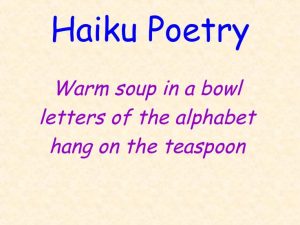
Timeline Of Nick’s Life In Poetry
There are poets and visionaries—souls who write to reveal the truth hidden in the ordinary,
Check out our store for the latest sales and promotions

As teachers, we are always looking for new and creative ways to inspire our students’ creativity and critical thinking, and support attentiveness in this age of distraction. Poetry is an effective weapon in this quest because of its emotional depth and beautiful cadence. Haiku is unique among poetry styles because of its tremendous impact and simplicity.
Haiku, which originated in Japan, inspires pupils to pay close attention to the world and communicate their ideas clearly using critical thinking skills to make careful word choices because of its brief format. One of NVHA’s goals at The Writers House in Waterfront South is to foster poetry that has a profound emotional impact on people. We honor both ancient and modern forms via community, workshops, and creation.
Knowing how haiku differs from other poetry and what makes this simple form stand out in the vast array of other poetic forms is crucial as you start or advance your poetic journey. Haiku’s distinctive thematic simplicity will be examined in this blog, along with how it differs from other forms and why it still has such a powerful effect. Together, let us explore syllables, stanzas, and quiet.
Before diving into lesson plans, it’s crucial to grasp the fundamentals of haiku. Traditionally, a haiku consists of three lines with a syllabic pattern of 5-7-5. However, modern haiku often prioritize the essence of the moment over strict syllable counts. The key elements include:
Kigo: A seasonal reference that grounds the poem in nature.
Kireji: A cutting word that provides a pause or emotional punctuation.
Implementing haiku lesson plans can be both fun and educational. Here’s a step-by-step guide to bring structured haiku lessons to your classroom:
Begin with a discussion on the history and structure of haiku. Share examples from renowned poets like Matsuo Bashō to illustrate the form’s depth and simplicity. Have students read some haiku aloud and choose their favorites – and share what it is that they like about each. Let the class explore which words in each really make the poem impactful.
Take students outside or have them observe their surroundings. Ask them to note what they see, hear, smell, and feel. Have them close their eyes for a moment and see what else they experience. This activity enhances their sensory awareness, a critical skill in haiku writing. This is called a ‘ginkgo walk’ – a contemplative walk to take in nature and inspire poetry.
Have students list words and phrases that capture their observations. Encourage them to think about emotions and imagery. Encourage them to find rich and clear words that are specific. For example, how many words they can generate for “blue” or how many kinds of birds do they know.
Using their word lists, students can start crafting their haiku. Remind them to focus on a single moment or image.
Allow students to share their haiku with classmates. Constructive feedback fosters a supportive learning environment.
Compile the haiku into a class anthology or display them on a bulletin board. Make a podcast. Publish a chap book. Celebrating their work boosts confidence and appreciation for poetry.
By following these steps, you’ll see how students respond to these activities, often with enthusiasm and creativity.
Haiku isn’t limited to language arts; it can enhance learning across the curriculum:
After studying ecosystems, students can write haiku about specific habitats or animals.
Encourage haiku that reflect historical events, current events or cultural practices.
Combine haiku with visual art projects, allowing students to illustrate their poems.
Connecting classroom activities to real-world experiences enriches learning. Consider these real-world poetry programs that inspire:
Participate in contests like the Nicholas A. Virgilio Memorial Haiku and Senryu Competition, which encourages young poets to showcase their talent.
Collaborate with local organizations to display student haiku in public spaces, fostering community engagement. Use chalk to create sidewalk haiku around the school.
Invite poets to conduct workshops or readings, providing students with firsthand insights into the poetic process.
To further immerse students in the art of haiku, consider organizing a dedicated workshop. Here’s how to schedule a haiku workshop for your school:
Determine the goals of the workshop, such as enhancing writing skills or exploring cultural aspects of haiku.
Reach out to local poets or organizations like NVHA to lead the session.
Decide on the date, duration, and necessary materials. Ensure the workshop aligns with your curriculum.
Promote the workshop to generate interest. Incorporate pre-workshop activities to prepare students.
After the workshop, encourage students to share their experiences and creations, reinforcing their learning.
Haiku can be introduced as early as elementary school! Younger students enjoy the simplicity of the 5-7-5 structure, while older students can explore deeper themes like nature, emotion, and mindfulness. With the right haiku lesson plans, you can adapt the learning experience to suit any age group—from creative fun for 2nd graders to reflective writing for high schoolers.
Not at all! Haiku’s beauty lies in its simplicity and accessibility. Many teachers begin by learning right alongside their students. Using the right poetry education resources, you can confidently guide students through structured writing exercises, group readings, and even nature walks for inspiration. You’ll be amazed at how students respond to these activities with curiosity and creativity.
Try combining haiku writing with real-world experiences—like creating a class haiku wall, hosting a mini poetry slam, or scheduling a guest poet. You can even schedule a haiku workshop for your school through local poetry organizations. These hands-on experiences make teaching haiku more dynamic, helping students engage with language, nature, and emotion in a meaningful way.
(Robin can send data on haiku and mindfulness to use here -)
(Many students say they find haiku to be an expressive form that lets them become more self-aware and share difficult emotions with others in a creative, safe, artistic way…. Robin can send statements from actual students to use to generate this section. NOTE: MINDFULNESS, ATTENTION AND TRAUMA SHOULD ALSO BE KEYWORDS WE ADDRESS)
Including haiku in your lesson plans provides a special way to help kids develop their self-expression (even about difficult subject matter), creativity, and awareness as well as attention to detail. Its succinct format forces them to condense difficult ideas into profoundly straightforward statements. You may establish a dynamic and stimulating learning environment by putting structured haiku lesson plans into practice, participating in interdisciplinary activities, and establishing connections with the larger poetry community.
Recall that teaching haiku involves more investigation and discovery than it does writing. If you embrace the process, you will see how your students develop into perceptive, considerate, and articulate people.

There are poets and visionaries—souls who write to reveal the truth hidden in the ordinary,

New Jersey’s Camden. A city that had been a titan of shipbuilding and industry, more

Words that will reverberate over time were once written by a quiet voice amid the
Copyright © 2025 Nick VIrgilio Haiku Association. All rights reserved.

Alfred taught English to junior and senior high school students in New Jersey and Massachusetts prior to working for the municipal government of the City of Camden, New Jersey. He began working with the City of Camden Department of Planning & Development, Division of Housing Services, as a Cost Estimator for Property Improvement in 1984.
He spent the next thirty-eight years working in both the Division of Housing Services, and the Finance Department Bureau of Grants Management, helping the City administer state and federally funded affordable housing projects in Camden.
Alfred spent ten years working with the Bureau of Grants Management, where he reviewed and evaluated grant applications and proposals for funding from non-profit and for- profit housing developers. These agencies included St. Joseph’s Carpenter Society, Heart of Camden, Camden County OEO, Habitat for Humanity,
Camden Lutheran Housing, RPM Development and others. He also worked with social service agencies such as Dooley House, Respond Inc., Sikora House, Center for Family Services, and Volunteers of America, that applied for grant funding.
He also played a significant role in the planning and implementation of the Annual Consolidated Plan grant application submitted to the Department of Housing and Urban Development each year. The Bureau holds an annual grant funding seminar along with public meetings and technical assistance sessions concerning the C-Plan.
Working for the City of Camden Division of Housing Services Alfred also served as the coordinator of the federal funded HOPWA housing Program for 14 years.
HOPWA funds provided safe, affordable, secure, housing for persons with HIV/AIDS, by issuing housing vouchers to their participants. He managed the delivery of services to 80-90 clients a year, covering Camden, Burlington and Gloucester counties.
During his time working for the City of Camden Mr. Dansbury was a member of the CPAC Homeless Network Planning Committee, the Local Law Enforcement Block Grant Advisory Committee and United Neighbors of Whitman Park.
Outside of his work with the City of Camden, Alfred worked as an Adjunct Instructor of Reading Skills and Writing Skills at Camden County College, teaching at both the Camden and Blackwood campuses. In 2022 Alfred published,
“The Strength of Courage” a novel he embarked on as a graduate student in Rowan University’s M.A. in Writing program in 2014-2018.
He earned a Bachelor of Arts in English and Journalism from Rutgers University, a Master’s of Arts degree in Business Administration from Eastern University, a Master’s of Arts in Education from Eastern Michigan University and a Master’s of Arts in Writing from Rowan University.